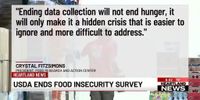The U.S. Department of Agriculture (USDA) has announced it will discontinue its annual food insecurity survey, a move that has ignited fierce debate among policymakers, anti-hunger advocates, and food security experts across the country. The 2024 Household Food Security Report, set for release on October 22, will be the last of its kind after nearly three decades of tracking hunger and food insecurity in the United States. This decision, first reported by The Wall Street Journal and later confirmed by the USDA, has drawn sharp criticism for its timing and potential consequences, particularly as federal nutrition aid faces historic cuts and grocery prices soar to unprecedented levels.
The annual survey, which has been published since the late 1990s, has served as the nation’s central tool for measuring Americans’ access to adequate food. According to the USDA’s most recent report, over 47 million Americans experienced some form of food insecurity in 2023—three million more than the previous year. The report found that 13.5% of U.S. households struggled with food insecurity at some point in 2023, up from 12.8% in 2022. Of these, 11.2 million households were classified as having low food security, while 6.8 million households (about 5% of all households, representing 12.2 million adults) were deemed to have very low food security, meaning their normal eating patterns were disrupted due to lack of resources. The impact on children was particularly concerning: 7.2 million children lived in food-insecure households, and nearly 850,000 children—about 1.2% of the total child population—lived in homes with very low food security.
For decades, lawmakers at federal, state, and local levels have relied on these reports to allocate funding for food assistance initiatives and evaluate their effectiveness. Heartland food banks and organizations like the Mid-Ohio Food Collective have used the data to identify vulnerable populations, including seniors, young people, and families, and to ensure that aid reaches those most in need. As reported by Reuters, Megan Lott, deputy director for the Healthy Eating Research program at Duke University, emphasized, “To say it’s duplicative is a little misleading because this is the most comprehensive source we have.”
Yet, the USDA has defended its decision, labeling the survey as “redundant, costly, politicized and extraneous.” In a news release, the department asserted, “These redundant, costly, politicised and extraneous studies do nothing more than fearmonger.” The USDA further criticized the methodology, claiming, “The questions used to collect the data are entirely subjective and do not present an accurate picture of actual food security.” The department argued that trends in food insecurity have remained “virtually unchanged, regardless of an over 87% increase in SNAP spending between 2019-23.” The USDA stated it will instead “prioritize statutory requirements and, where necessary, use the bevy of more timely and accurate data sets available to it.”
However, many experts have pushed back hard against this rationale. Elaine Waxman, a food insecurity measurement expert at the Urban Institute, told The New York Times, “In no way does that reflect the view of anybody who works with the data. That is completely a pretext for eliminating data that can point out problems.” Lindsey Smith Taillie, a nutrition professor at the University of North Carolina Gillings, echoed these concerns in comments to The Wall Street Journal: “I think the only reason why you wouldn’t measure it is if you were planning to cut food assistance, because it basically allows you to pretend like we don’t have this food insecurity problem.”
The timing of the survey’s cancellation has fueled suspicions. In July 2025, President Donald Trump signed into law a sweeping tax and spending bill that included the largest cuts to the Supplemental Nutrition Assistance Program (SNAP) in history—about 20% of the program’s budget, totaling $187 billion through 2034. The Congressional Budget Office estimates that around four million Americans, or roughly 10% of SNAP recipients, will lose some or all of their benefits as a result. The cuts also introduce expanded work requirements for recipients and new state cost-sharing mandates that could strain already stretched state budgets.
Critics argue that eliminating the survey now will make it nearly impossible to assess the real-world impact of these cuts. Eric Mitchell, president of the Alliance to End Hunger, told Reuters, “There’s no way to determine what that impact will look like if the government isn’t tracking the data.” Georgia Machell, president and CEO of the National WIC Association, added that the loss of this data will also make it more difficult to ensure the efficacy of other federal nutrition programs, including the Special Supplemental Nutrition Program for Women, Infants, and Children (WIC).
The USDA maintains that “the data is rife with inaccuracies slanted to create a narrative that is not representative of what is actually happening in the countryside as we are currently experiencing lower poverty rates, increasing wages, and job growth under the Trump Administration.” But food security experts counter that the survey, which draws on the Census Bureau’s Current Population Survey, is the only data set that provides both national and state-level statistics, making it indispensable for targeted policy interventions.
Meanwhile, the backdrop to this policy shift is a landscape of rising need and economic strain. Food banks across the nation have reported surges in demand, with some seeing more visits than during the peak of the COVID-19 pandemic. Inflation and the winding down of pandemic-era aid have left many households struggling to afford basic groceries. Climate change has also played a role, driving up the prices of everyday staples like beef and eggs to record highs. Despite these challenges, the Trump administration has removed references to climate change from the USDA’s website and shuttered the scientific research arm of the Environmental Protection Agency, actions that critics say further undermine efforts to address the root causes of food insecurity.
The decision to end the survey has not gone unnoticed in the political arena. Bobby Kogan, senior director of federal budget policy at the Center for American Progress, said on social media, “Trump is cancelling an annual government survey that measures hunger in America, rather than allow it to show hunger increasing under his tenure. This follows the playbook of many non-democracies that cancel or manipulate reports that would otherwise show less-than-perfect news.” Colleen Heflin, a professor at Syracuse University who has studied the data since its inception, warned, “Not having this measure for 2025 is particularly troubling, given the current rise in inflation and deterioration of labour market conditions, two conditions known to increase food insecurity.”
As the nation prepares for the release of the final Household Food Security Report next month, the future of hunger measurement in America remains uncertain. Without this annual survey, advocates worry that millions of struggling families may become invisible in the data—and that policymakers will be left flying blind in the fight against hunger. The stakes, as experts and advocates alike have made clear, could not be higher.

